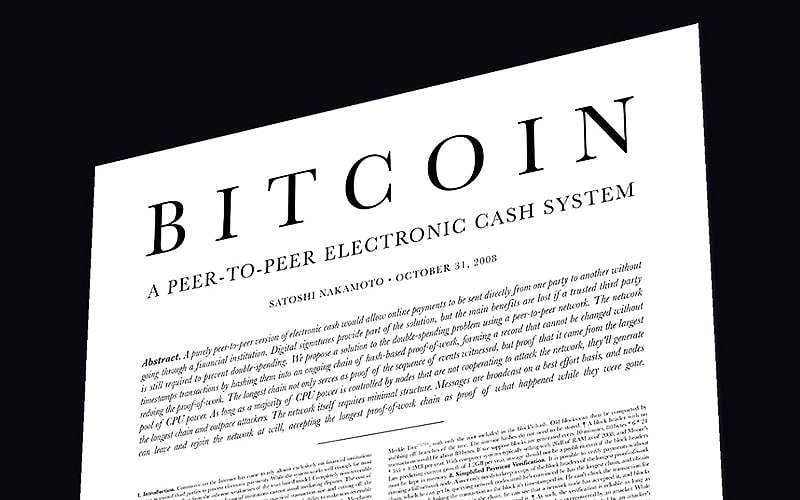On April 11, 2024, marks the release of the initial Bitcoin software (version 0.1) by an anonymous individual or group, or an entity known as Satoshi Nakamoto, on SourceForge. This event also initiated the creation of the first block in the Blockchain network, referred to as the genesis block.
The creator of Bitcoin, identified as Nakamoto, included the title of an article published by ‘The Times’ of the UK on January 3, 2009, as a timestamp in the initial transaction of the genesis block.
Title from The Times on January 3, 2009: Chancellor Nears Preparation for Banks’ Second Bailout – A veiled criticism of the precarious banking system.

Over the past 15 years, the financial sector has undergone a significant transformation, with the emergence of a new and rapidly expanding market: cryptocurrencies. Valued at an impressive $2.81 trillion, this ecosystem is seen as the potential future of monetary transactions.
Bitcoins initial worth was negligible, but now holds a value of approximately US $70,000. Some market experts anticipate that following the 2024 halving event, its price could surge beyond US $150,000.

Nakamoto proposed integrating an algorithm into the blockchain program that reduced the Bitcoin rewards given to miners upon reaching the milestone of mining 210,000 blocks.
Yet, the true identity of Satoshi Nakamoto, a mystery hidden from the public for the last 15 years, remains unrevealed.
Searching the internet reveals numerous theories regarding Nakamoto’s true identity.
There are varying beliefs about this person’s background. Some argue that they are of Japanese descent, while others suggest it could have been a covert operation by the CIA or the illuminati. A few even propose the possibility that it was the bigfoot.

Several individuals have put forth their claim as the possible identity behind the pseudonym Nakamoto. Some have made this assertion themselves, while others have been suggested by conspiracy theorists and investigative journalists. However, none have managed to produce sufficient proof to definitively establish this connection.
Failed attempts to trace Satoshi Nakamoto
The name Satoshi Nakamoto is of Japanese origin. Its meaning can be translated as “wisdom (Satoshi) and one who honors (Nakamoto)” or “clear-thinking (Satoshi) and the champion (Nakamoto)”. Bitcoin community widely accepts this interpretation of the name.
Several people around the world have been identified as potential candidates for Nakamoto’s true identity, but so far, no one has been able to definitively solve the enigma.
Three well-known individuals believed to be connected to the pen name Satoshi Nakamoto are Dorian S. Nakamoto, a Japanese-American engineer, Craig Wright, an Australian computer scientist, and Nick Szabo, the creator of Bitgold.

Of the three individuals, Dorian Nakamoto is a physics graduate hailing from California Polytechnic State University. Inaccurately, he was identified as the creator of Bitcoin based on a news article published in 2014. However, Mr. Nakamoto refuted these claims, issuing a statement to clarify that he had no role whatsoever in the development of Bitcoin or its underlying technology, the blockchain.
Similarly, computer scientist and cryptographer Nicholas Szabo has been attributed as the real Satoshi Nakamoto owing to his invention of Bitgold back in 1998, which is a precursor to Bitcoin. Szabo is also credited with developing ‘smart contracts’, a digital agreement stored in blockchain networks. He has also denied being the real Nakamoto back in 2014.
Among the three known individuals, Craig Wright, an Australian computer scientist, stands out as the only one who has publicly asserted that he is Satoshi Nakamoto, the Bitcoin creator. Nevertheless, in March 2024, a British court decided against Wright’s claim, declaring him not to be Nakamoto.
Although the true name of Nakamoto is still a mystery, it’s possible that the person or people behind this alias intended for attention to be given primarily to their groundbreaking message rather than themselves.
We’re led to Satoshi’s whitepaper, published on October 31, 2008, on a freshly registered domain called bitcoin.org. The inventor labeled the digital currency as “Bitcoin: A Decentralized Digital Money.”
Satoshi’s White Paper

In simple terms, Satoshi’s white paper on bitcoin.org published in 2008 is often referred to as the foundational text of cryptocurrency. It outlines the concept behind Bitcoin and explains how blockchain technology enables direct digital transactions between individuals without requiring a third-party intermediary, which is commonly used in traditional banking for validating transactions at a fee.
Beginners in the world of cryptocurrencies often refer back to Satoshi’s whitepaper as a reliable resource for understanding the fundamental concepts of blockchain technology correctly.
An electronic payment method using cryptographic verification rather than relying on trust between parties is what’s proposed. This system enables any two individuals to conduct transactions directly with one another, bypassing the requirement for a trusted intermediary.
The document outlines the design of the bitcoin software, which employs a decentralized system called a “peer-to-peer distributed timestamp server,” to confirm the sequential order of transactions through cryptographic proof.
Satoshi’s Net Worth and his/her/their future
Following the unveiling of the genesis blockchain, Satoshi was an active participant for the following two years. However, after this period, there were no further signs of their presence. It is speculated that Satoshi owns between 750,000 and 1.1 million Bitcoins, acquired since 2010. This translates to a net worth surpassing $72 billion, positioning them among the world’s wealthiest individuals.
There’s a lot of discussion online about the potential unmasking of Satoshi, the mysterious creator of Bitcoin. Some people believe that governments may recognize him for his achievements in the crypto world, while others think law enforcement could pursue him for tax-related issues if his identity is ever disclosed.


Another interpretation is that Nakamoto’s influence will endure, leaving a lasting impact on computer science, programming, and cryptocurrency communities for generations to come.
In simpler terms, the story of Nakamoto could be paraphrased as “the concept, not the person, is what we should remember because a person can err, be captured, or perish, but an idea with enduring power can transform the world even after four centuries.”

Graphics and Illustrations by Kartik Shah
Read More
- Mech Vs Aliens codes – Currently active promos (June 2025)
- Gold Rate Forecast
- Honor of Kings returns for the 2025 Esports World Cup with a whopping $3 million prize pool
- Silver Rate Forecast
- Every Upcoming Zac Efron Movie And TV Show
- Grimguard Tactics tier list – Ranking the main classes
- Hero Tale best builds – One for melee, one for ranged characters
- Kanye “Ye” West Struggles Through Chaotic, Rain-Soaked Shanghai Concert
- Gods & Demons codes (January 2025)
- EUR USD PREDICTION
2024-04-12 15:58